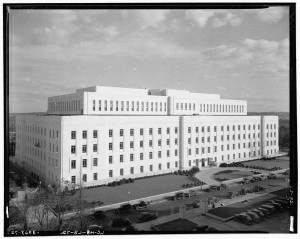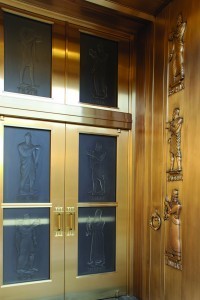The Library in History: The John Adams Building at 75

The Library of Congress John Adams Building. ca. 1939. Prints and Photographs Division.
Seventy-five years ago, the Library opened a second building on Capitol Hill to house its growing collections.
With a collection of more than 3.5 million items, former Librarian of Congress Herbert Putnam reported to Congress in 1926 that the nearly completed bookstack “will not be likely to take care of the accessions beyond the coming decade.” Thus began his push for an Annex Building.
In 1935, Congress approved and President Herbert Hoover signed a total congressional appropriation providing $8,226,457 for the construction of a second building to be located east of the existing building on land that had been acquired in 1928.
Faced in Georgian marble, the building is a wonderful example of the Art Deco design movement, which first appeared in France after World War I. Various artisans and manufacturers contributed to the beauty of the building. The building was constructed under the auspices of the Works Progress Administration, a federal agency that employed millions of unemployed people during the Depression. The project was listed in President Roosevelt’s National Industrial Recovery Act, which authorized a variety of public works.
When the building opened to the public on Jan. 3, 1939, it was called “the Annex.” On April 13, 1976, in a ceremony at the Jefferson Memorial marking the birthday of Thomas Jefferson, President Gerald Ford signed into law the act to change the name of the Annex Building to the Library of Congress Thomas Jefferson Building.The original Library of Congress structure was then dubbed “The Main Building.”
The South Reading Room of the Annex Building is a tribute to Thomas Jefferson and was referred to as the Thomas Jefferson Reading Room. His image is captured in a lunette overlooking the reading room.
The designation of the Annex as the Thomas Jefferson Building was short-lived. In the 1960s, President Lyndon Johnson had authorized a congressional appropriation of $75 million to construct a third Library of Congress building to be named for nation’s fourth president. In 1980, the James Madison Memorial Building opened to the public and Congress passed a law that changed the names of both existing Library buildings. The main building was named the Thomas Jefferson Building and the Annex became the John Adams Building, in honor of second president John Adams, who, on April 24, 1800, signed the law that established a library for Congress in 1800.

Adams Building doors. Photo by Shealah Craighead.
The building’s classical architecture features a series of large bronze doors depicting the history of the written word in high-relief sculpted figures designed by American artist Lee Lawrie, who is best known for the architectural sculptures on and around New York’s Rockefeller Center.
The doors, located at the entrance to the Adams building, showcase various deities and mythological characters such as Hermes, who was attributed with inventing the alphabet; Odin, the originator of the science of written communication in Norse mythology; and Quetzalcoatl, revered as the inventor of books in Aztec culture.
Under the auspices of the Architect of the Capitol, the bronze doors to the John Adams Building were replaced recently with code-complaint sculpted glass panels mirroring the original bronze door sculptures. The Washington Glass studio and Fireart Glass of Portland, Ore., created the new doors.
The following is an article featured in the March-April 2014 issue of the Library of Congress Magazine, LCM, now available for download here. You can also view the archives of the Library’s former publication from 1993 to 2011.
Library of Congress's Blog
- Library of Congress's profile
- 74 followers



